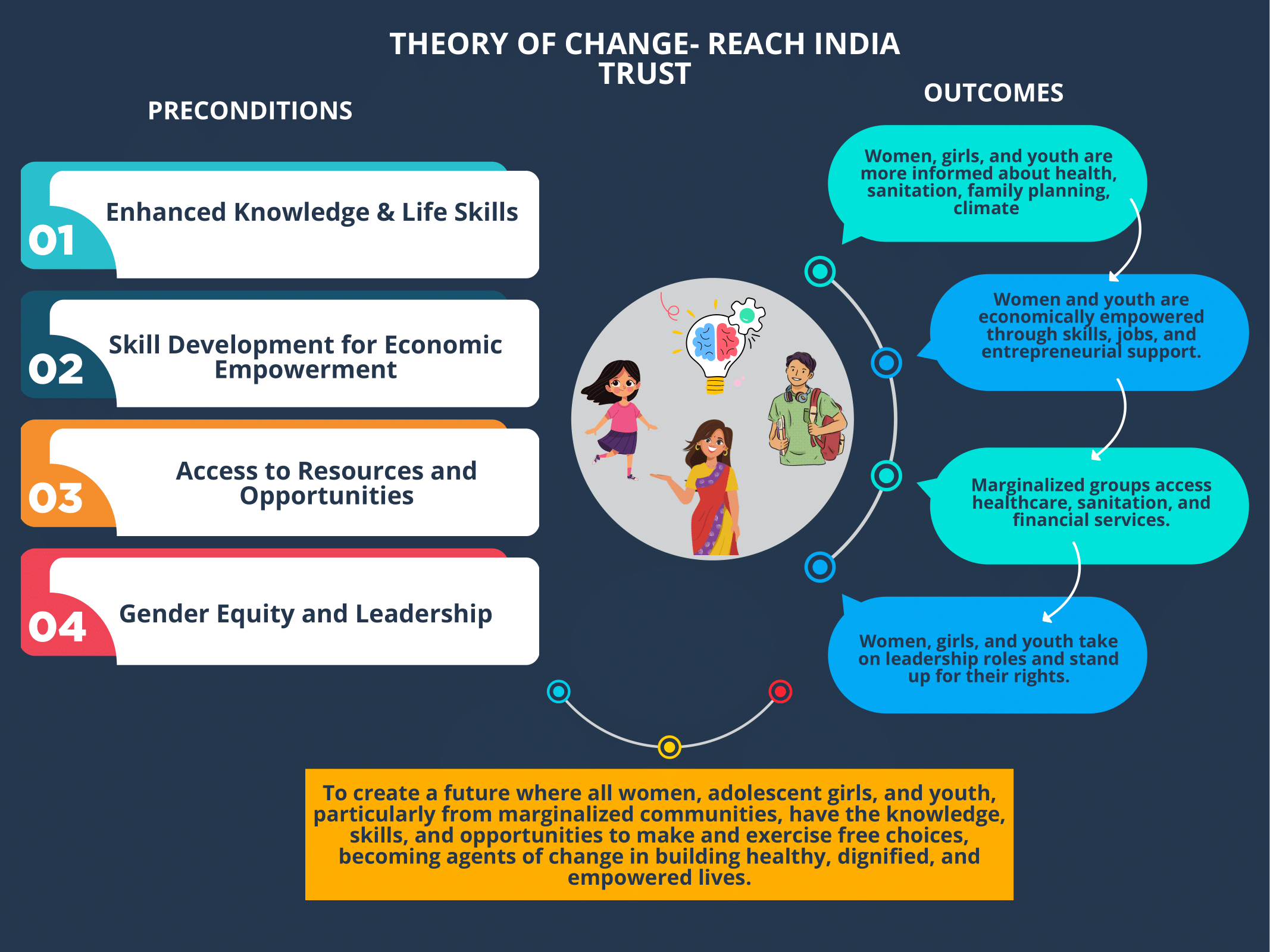GOAL
To create a future where all women, adolescent girls, and youth, particularly from marginalized communities, have the knowledge, skills, and opportunities to make and exercise free choices, becoming agents of change in building healthy, dignified, and empowered lives.
Pathway to Change
- Precondition 1: Enhanced Knowledge & Life Skills
- Outcomes: Women, girls, and youth have improved knowledge of health, sanitation, family planning, climate change, and financial literacy.
- Interventions:
- Implement life skills education and awareness programs.
- Provide training on sexual and reproductive health, water sanitation, hygiene, and financial literacy.
- Create climate change adaptation and awareness programs.
- Precondition 2: Access to Resources and Opportunities
- Outcomes: Marginalized women, girls, and youth have access to critical services, such as healthcare, family planning, sanitation, and financial services.
- Interventions:
- Strengthen partnerships with healthcare providers for reproductive health and family planning services.
- Facilitate financial inclusion through microcredit, financial literacy training, and vocational skills programs.
- Collaborate with local governments for improved access to water and sanitation infrastructure.
- Precondition 3: Skill Development for Economic Empowerment
- Outcomes: Women and youth are economically empowered through job placements, entrepreneurship, and livelihood opportunities.
- Interventions:
- Provide skill development programs aligned with market needs (e.g., IT skills, vocational training).
- Partner with private and government organizations for job placement and entrepreneurial support.
- Facilitate business development services and access to microloans for small enterprises.
- Precondition 4: Gender Equity and Leadership
- Outcomes: Women, girls, and youth are empowered to take on leadership roles within their communities and challenge harmful social norms.
- Interventions:
- Conduct community mobilization and awareness programs on gender equality and women’s rights.
- Establish women and youth leadership forums to promote agency in decision-making processes.
- Collaborate with other organizations for gender policy reform and social campaigns.
Assumptions
- Communities are willing to participate in skill development and health programs.
- There are enabling policies that support access to healthcare, financial inclusion, and women’s empowerment.
- Partnerships with local governments and NGOs will be effective in improving infrastructure and services.
- Cultural norms can shift through sustained education and awareness.
Indicators of Success
- Increase in the number of women and youth accessing health and family planning services.
- Higher rates of job placement or business establishment among trained youth and women.
- Reduction in dropout rates for girls from schools due to life skills training and WASH (Water, Sanitation, and Hygiene) initiatives.
- Women and youth assuming leadership roles in their communities.
This Theory of Change outlines how RIT can continue to drive its mission of transforming the lives of marginalized groups through holistic and integrated interventions in skills development, health, sanitation, climate action, and financial inclusion.
Theory of Change Matrix for Reach India Trust (RIT)
Precondition | Outcomes | Interventions | Indicators | Assumptions |
1. Enhanced Knowledge & Life Skills | Women, girls, and youth are more informed about health, sanitation, family planning, climate change, and financial literacy. | – Conduct life skills education programs. | – % of participants who demonstrate improved knowledge in health, family planning, WASH, and climate change. | – Communities will engage in educational initiatives. |
2. Access to Resources and Opportunities | Marginalized groups access healthcare, sanitation, and financial services. | – Partner with healthcare providers for reproductive health services. | – % increase in access to reproductive health services. | – Local infrastructure will support access to services. |
3. Skill Development for Economic Empowerment | Women and youth are economically empowered through skills, jobs, and entrepreneurial support. | – Provide market-aligned skills training. | – % of trained participants employed or self-employed. | – Market demand exists for trained skills. |
4. Gender Equity and Leadership | Women, girls, and youth take on leadership roles for their rights. | – Develop gender sensitized cadres for establishing Gender friendly environment. | – % increase in women/youth in leadership positions. | – Communities are receptive to women’s leadership. |
Explanation of Key Columns
- Precondition: The critical conditions needed to achieve the long-term impact.
- Outcomes: The specific changes expected as a result of the interventions.
- Interventions: Activities and programs implemented to achieve the outcomes.
- Indicators: Metrics to measure the success of the interventions and progress towards outcomes.
- Assumptions: External factors or conditions believed to hold true for the Theory of Change to be effective.
This matrix can serve as a guide for planning, monitoring, and evaluating RIT’s work, ensuring alignment with its mission and long-term impact goals.


